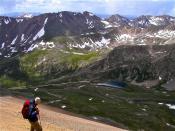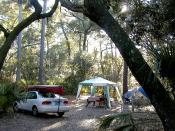Backpacking: A Different Way of Camping
What is camping? To most people, it is perceived as a time to pack up the car, drive to local camp grounds, and spend the weekend in the great outdoors. It is a time to frolic with family and friends around a campfire, singing songs, playing games, and roasting marshmallows while listening to ghost stories that can only be heard while camping. However, to the avid backpacker, camping takes on a different perspective. While experiencing the great outdoors is very similar to car camping, backpacking is very different in many respects. Preparation for backpacking and car camping and the locales where one can set up camp are very different. In either case, experiencing the great outdoors and its natural beauty cannot be surpassed.
With car camping the only real limitation is one's vehicle. A person is limited to the vehicle's capacity to carry or tow.
For example, a camper will bring a stove, a twelve man tent, two coolers of meat and potatoes, five gallons of water, and maybe tow a camper. On the other hand, when backpacking, the circumstances are very different. One is limited to his or her own capabilities: the amount of weight that can be carried, endurance levels, just to name a few. Provisions must be carefully measured. If overloaded, it can affect performance while hiking to one's destination, but if not enough provisions are carried it, will impact how long one can last out in the wilderness. The equipment must be minute in size and weight. Special lightweight stoves, tents, sleeping bags, and clothes must be used when backpacking. The average weight of a full backpack is about thirty-five pounds. A camper is completely dependent on what is in his or her backpack to survive in nature.
Reaching one's final destination for car camping and backpacking are also very different. To get to the campsite while car camping, one follows a road map to the park, drives to the ranger station, picks up a pass, and pulls in to the campsite. Depending on the size of the park, there are usually fifty to one hundred campsites filled with weekend warriors. While backpacking, reaching the campsite is a greater task. First, the backpacker enters the park, gets a pass from the ranger station, and drives to the trailhead. At the trailhead one loads his or her gear in the backpack and firmly attaches it to their waist and back. Finally, the backpackers hikes two to twelve miles to reach their destination, following a topographical map and utilizing a compass. If one is fortunate, there will be someone camping at the same site. Backpacking is usually done by oneself or in a group.
Going to the restroom is also very different in both cases. For one, there are no portable restrooms while backpacking. A shovel and toilet paper are a backpacker's only means. One picks a spot, digs a hole, and squats. It is a very peaceful experience with the birds chirping, the wind blowing, and trees swaying. While car camping, there is usually a communal restroom that almost always smells of disinfectants or deodorants.
Car camping and backpacking are two forms of camping that differ from each other in the respect that backpacking is a more independent form of camping. If one feels like escaping the city just for a few days, one can hop into a car and drive to a campground. It is relatively easy to prepare for car camping, but backpacking is much more rigorous and requires much planning. Though more limiting in what one can carry, backpacking allows a person to see the outdoors in a way that car camping cannot. The most beautiful sights are seen while backpacking, and this is because a car can only take one so far. Most backpackers experience something that most car campers will never see: the beauty of nature untouched by common man. Regardless of the mode of exploring the great outdoors, an exciting adventure awaits.


